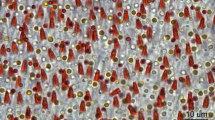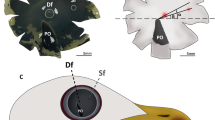Summary
We studied visual optics using ophthalmoscopy in six species of coraciform birds, five species from the family Alcedinidae (kingfishers) and one from the family Meropidae (bee-eaters). All six species had large angular separations between the two foveae of one eye (angle α); angle α was greater than 40° in all cases, the largest separation so far reported for any group of vertebrates. In all kingfishers, but not in the bee-eater, the plane containing the projections of both foveae in one eye (angle ϑ) was rotated from the horizontal plane so that the projection of the monocular fovea was lower than the projection of the binocular fovea.
Retinal ganglion cell isodensity maps were obtained for the sacred kingfisher (Halcyon sancta) and laughing kookaburra (Dacelo gigas). These maps were constructed in the usual way for the peripheral regions of the retina. For the high-density, multi-layered, central region of the retinal ganglion cell layer, we used a combined retinal wholemount-cross-sectional technique. It was discovered that the ‘horizontal streak’, formed by the elliptically shaped contours of retinal ganglion cell isodensity, deviated inferiorly at its nasal extent from the line of the foveae. This deviation had the same sign, and slightly greater magnitude, as the rotation (angle ϑ) observed ophthalmoscopically when the eyes were in their primary position.
Our new observations provide new insights into the functional significance of the bifoveate visual organization. In particular, the relationship between angle α and angle ϑ suggests one strategy which could be used by kingfishers to maximize their visual capabilities when hunting from a perch above the substrate.
Similar content being viewed by others
References
Abercrombie M (1946) Estimation of nuclear population from microtome sections. Anat Rec 94:239–247
Barlow HB (1981) Critical limiting factors in the design of the eye and visual cortex. Proc R Soc Lond B 212:1–34
Brown M (1982) Physiological optics of bifoveate birds. B. Sc. Hons Thesis, National Vision Research Institute of Australia and University of Melbourne, Victoria, Australia
Collett TS, Harkness LIK (1982) Depth vision in animals. In: Ingle DJ, Goodale MA, Mansfield RJW (eds) Analysis of visual behaviour. M.I.T. Press, Cambridge Massachusetts London, pp 111–176
Cotonnier M, Beaulieu C (1985) An empirical assessment of stereological formulae applied to the counting of synaptic discs in the cerebral cortex. J Comp Neurol 231:175–179
Cooper ML, Pettigrew JD (1979a) A neurophysiological determination of the vertical horopter in the cat and owl. J Comp Neurol 184:1–26
Cooper ML, Pettigrew JD (1979b) The decussation of the retinothalamic pathway in the cat, with a note on the major meridians of the cat's eye. J Comp Neurol 187:285–312
Fite KV, Lister BC (1981) Bifoveal vision in anolis lizards. Brain Behav Evol 19:144–154
Fite KV, Rosenfield-Wessels S (1975) A comparative study of deep avian foveas. Brain Behav Evol 12:97–115
Fry CH (1980) The evolutionary biology of kingfishers (Alcedinidae). Living Bird 18 (1979–1980):113–160
Fry CH (1984) The bee-eaters. T and AD Poyser, Calton, England
Greig-Smith PW (1978) Behaviour of woodland kingfishers in Ghana. Ostrich 49:67–75
Greig-Smith PW (1979) Selection of feeding areas by senegal kingfishersHalcyon senegalensis. Z Tierpsychol 49:197–209
Harkness LIK (1977) Chameleons use accommodation cues to judge distance. Nature 267:46–349
Harkness LIK, Bennet-Clark HC (1978) The deep fovea as a focus indicator. Nature 272:814–816
Hughes A (1985) New perspectives in retinal organisation. In: Osbourne NN, Chader GJ (eds) Progress in retinal research, vol 4. Pergamon Press, Oxford New York, pp 243–313
Pettigrew JD, Ramachandran VS, Bravo H (1984) Some neural connections subserving binocular vision in ungulates. Brain Behav Evol 24:65–93
Polyak S (1957) The vertebrate visual system. University of Chicago Press, Chicago London
Pumphrey RJ (1961) Part I. Sensory organs: Vision. In: Marshall AJ (ed) Biology and comparative physiology of birds, vol II. Academic Press, New York London, pp 55–68
Snyder AW, Miller WH (1978) Telephoto lens system in falconiform eyes. Nature 275:127–129
Stone J (1981) The wholemount handbook: A guide to the preparation and analysis of retinal wholemounts. Clarendon Press, Kensington, N.S.W., Australia
Wallman J, Pettigrew JD (1985) Conjugate and disjunctive saccades in two avian species with contrasting oculomotor strategies. J Neurosci 6:1418–1428
Walls GL (1942) The vertebrate eye and its adaptive radiation. Hafner, New York London
Wood CA (1917) The fundus oculi of birds especially as viewed by the ophthalmoscope. The Lakeside Press, Chicago, pp 1–180
Author information
Authors and Affiliations
Rights and permissions
About this article
Cite this article
Moroney, M.K., Pettigrew, J.D. Some observations on the visual optics of kingfishers (Aves, Coraciformes, Alcedinidae). J. Comp. Physiol. 160, 137–149 (1987). https://doi.org/10.1007/BF00609721
Accepted:
Issue Date:
DOI: https://doi.org/10.1007/BF00609721




